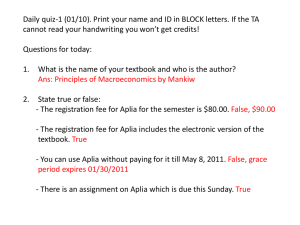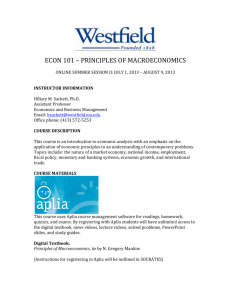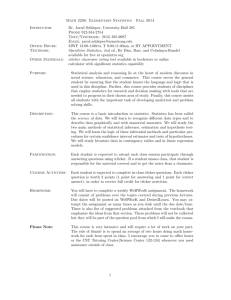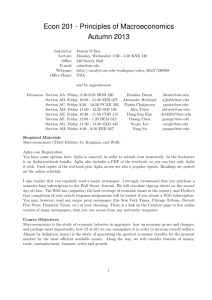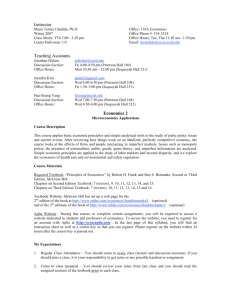Econ 201 Spring 2015 Syllabus - Erik Nesson's Website :: Ball State
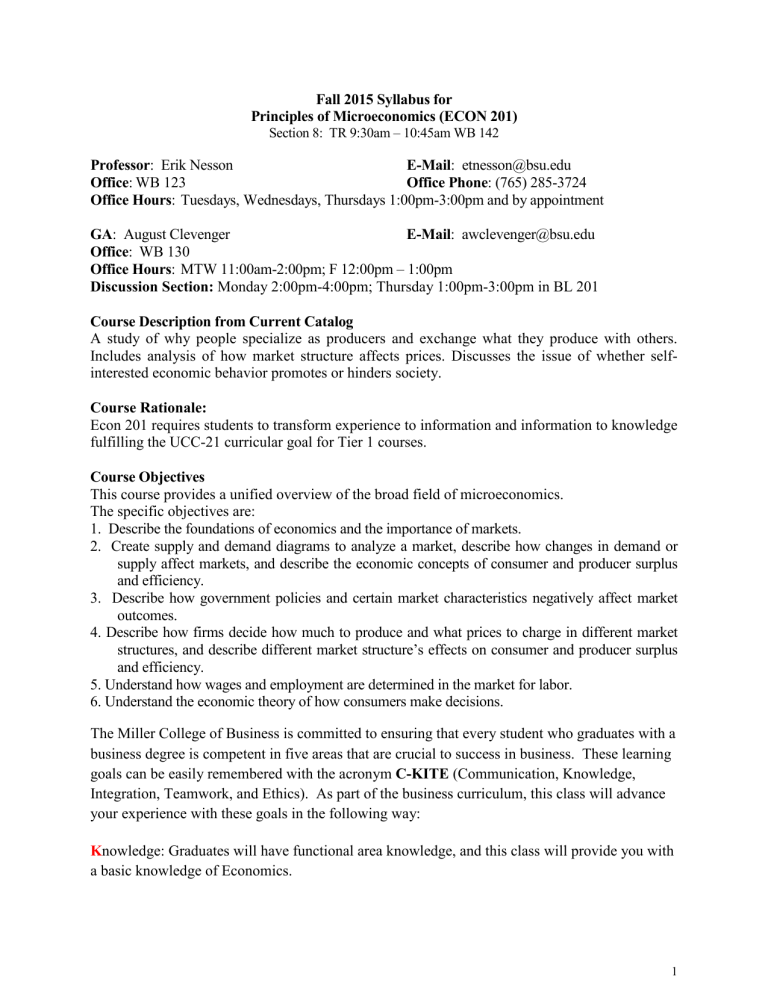
Fall 2015 Syllabus for
Principles of Microeconomics (ECON 201)
Section 8: TR 9:30am – 10:45am WB 142
Professor : Erik Nesson
Office : WB 123
E-Mail : etnesson@bsu.edu
Office Phone : (765) 285-3724
Office Hours : Tuesdays, Wednesdays, Thursdays 1:00pm-3:00pm and by appointment
GA : August Clevenger E-Mail : awclevenger@bsu.edu
Office : WB 130
Office Hours : MTW 11:00am-2:00pm; F 12:00pm – 1:00pm
Discussion Section: Monday 2:00pm-4:00pm; Thursday 1:00pm-3:00pm in BL 201
Course Description from Current Catalog
A study of why people specialize as producers and exchange what they produce with others.
Includes analysis of how market structure affects prices. Discusses the issue of whether selfinterested economic behavior promotes or hinders society.
Course Rationale:
Econ 201 requires students to transform experience to information and information to knowledge fulfilling the UCC-21 curricular goal for Tier 1 courses.
Course Objectives
This course provides a unified overview of the broad field of microeconomics.
The specific objectives are:
1. Describe the foundations of economics and the importance of markets.
2. Create supply and demand diagrams to analyze a market, describe how changes in demand or supply affect markets, and describe the economic concepts of consumer and producer surplus and efficiency.
3. Describe how government policies and certain market characteristics negatively affect market outcomes.
4. Describe how firms decide how much to produce and what prices to charge in different market structures, and describe different market structure’s effects on consumer and producer surplus and efficiency.
5. Understand how wages and employment are determined in the market for labor.
6. Understand the economic theory of how consumers make decisions.
The Miller College of Business is committed to ensuring that every student who graduates with a business degree is competent in five areas that are crucial to success in business. These learning goals can be easily remembered with the acronym C-KITE (Communication, Knowledge,
Integration, Teamwork, and Ethics). As part of the business curriculum, this class will advance your experience with these goals in the following way:
K nowledge: Graduates will have functional area knowledge, and this class will provide you with a basic knowledge of Economics.
1
Class materials:
(1) The required textbook for this course is Principles of Microeconomics by Greg Mankiw, 7 th
Edition. In addition to the textbook, we will be using Aplia, an online homework system accompanying the textbook. An electronic copy of the textbook and Aplia is available through Courseload and will be automatically added to your student fees for this semester.
Thus, there are no textbooks to buy. If you would like to purchase a hard copy of the textbook, I recommend finding a used copy of a previous version of the textbook. You should be able to find them on Amazon for less than $20.
To access Aplia and the textbook, click on the “Connect to Aplia and the Textbook” link in the “START HERE” folder in Blackboard. You’ll be taken to Aplia’s website where you can register with Aplia.
(2) i>clicker 2 (this should be available at the bookstore). If not you can order it through http://www.iclicker.com/purchase/ ). If you already own an older i>clicker, it will work for this class (You don’t need an i>clicker 2).
You must register your i>clicker through Blackboard in order to receive points. To do this, go to the Blackboard home page for this course, and click on the “i>clicker Registration Module”, and enter the i>clicker ID number located on the back of your clicker.
(3) You will likely need a calculator on most class days. Any calculator will do, including your cell phone. But you will need a separate calculator for the exams (no cell phones).
I will use Blackboard to post PowerPoint slides for class, homework assignments and answers, and other documents for class, as well as important announcements. The PowerPoint slides for class will only be partial slides, so you will have to attend class in order to fill in the missing information.
Determination of Grade in Course
The grade in the course will be based on exams, assignments and class participation as follows:
Exams: 60% total
•
There will be two midterm exams and a comprehensive final exam, which will be graded on the traditional 0 to 100 point scale. The midterm exams will consist of about 30-40 multiple choice questions and will be worth 15% of your final grade. The final exam will consist of about 50 multiple choice questions and be worth 30% of your final grade.
•
Missed exams will count as zeros, and you will be able to make up exams only if you can verify that your missed exam was due to extreme circumstances.
Any appeal of a test grade must be made within two weeks of taking the test.
Homework: 20% total
•
These problem sets are taken through Aplia and must be completed by the assigned dates and times. Aplia assignments will be due on various Sunday nights at 11:00pm throughout the semester. I will announce when problem sets are due in class, but is your responsibility to
2
keep track of when they are due through Blackboard or Aplia. I will drop your lowest problem set score. Late homework assignments will not be accepted.
Participation: 20% total
•
There will be in-class problems answered via the i>clicker system on most days throughout the semester, and your answers to these problems will comprise your participation grade.
•
You will earn a zero on a question if you are either absent from that class period or forget your i>clicker. I will drop your lowest three days of participation scores. Students absent for extreme circumstances or for participation in university events should let me know.
GRADING SCALE:
Grade % of Total Points
A
B
85% to 100%
75% to 84.9%
C
D
65% to 74.9%
55% to 64.9%
F Less than 55%
Since grades are weighted, the grade you see on Bb (based on your “points”) will not be indicative of your actual grade in the class. To roughly calculate your actual grade, use the following formula:
Grade = 0.6*(Average of Exams) + 0.2*(Average % HW Score) + 0.2*(Average % iClicker
Score).
3
Academic Integrity
You are expected to follow Ball State’s Academic Honor Code, which you can read here: http://cms.bsu.edu/About/AdministrativeOffices/StudentRights/PoliciesandProcedures/StudentC ode/VIIEthicsPolicy.aspx
Other Classroom Policies
•
Attendance is expected and required to earn participation credit. Come to class on time.
•
Computers are not allowed in the classroom. If you need to use a computer, please come see me after class or during office hours.
•
Cell phones should be turned off or on silent during class.
•
The best way to get a hold of me is by email or by stopping by my office hours. I will check my email as much as possible during the hours of 9am to 8pm during the weekdays, but I make no guarantees about reading or responding to emails sent later at night or over the weekend.
Keys to learning:
•
Print out the skeleton notes ahead of time and come to class on time.
•
Don’t neglect the LearnSmart assignments. They are designed to give you a basic understanding of the material before class.
•
Practice, practice, practice! In addition to the problem sets and Connect assignments, the back of the book contains answers to all even numbered problems in the book. For extra practice, try answering the even numbered problems.
•
If you encounter difficulty with the course material, you are strongly encouraged to seek help!
Visit my office hours or set up an appointment, visit the graduate assistants
Disability Accommodations
Ball State University was identified as a college that goes above and beyond the mandates of
Americans with Disabilities Act (ADA). If you need course adaptations or accommodations because of a disability, if you have emergency medical information to share with me, or if you need special arrangements in case the building must be evacuated, please make an appointment with me as soon as possible.
In order to qualify for extra time on exams or class notes, you will need a letter from the Disabled
Student Development office, located at the Student Center (SC), room 116.
4
Resources:
If you’re having trouble with the material, there are a number of resources at your disposal:
1.
My office hours
I will try to help students out as best I can during my office hours.
2.
The GA’s office hours
The graduate assistant for this class is Anika, and she is a Masters student in actuarial sciences
(applied statistics). She can help you out as well during her office hours, which are listed on page one of this syllabus.
3.
The peer tutor
This course has a peer tutor (TBA). This tutor will be able to help you out in understanding the material in this class.
4.
The Learning Center
For additional help, The Learning Center offers free tutoring for many courses in the University
Core Curriculum, for a variety of math, economics, accounting, and physics courses, for any writing task, and for general study strategies such as time management, test taking, speed reading, and effective textbook reading and note taking. They also tutor for many courses outside of the University Core Curriculum. Call 765-285-1006 or visit NQ 350 to make an appointment to meet with a tutor. The Learning Center is open Monday-Thursday 9am-8pm,
Friday 9am-12pm.
5
COURSE OUTLINE AND SCHEDULE:
Date CHAPTER TOPIC
8/25/2015 1 Introduction, What is Economics?
8/25/2015
9/1/2015
2, 3
4
What is Economics, PPF and Opportunity Cost
The Demand Curve
9/3/2015
9/8/2015
4
4, 7
The Supply Curve
Market Equilibrium, Consumer and Producer Surplus
9/10/2015
9/15/2015
4, 7
5
Market Equilibrium, Consumer and Producer Surplus
Elasticity
9/17/2015
9/22/2015
5
6, 8
Elasticity
Government Policies: Taxes and Subsidies
9/24/2015
9/29/2015
6, 8
10
Government Policies: Taxes and Subsidies
Externalities
10/1/2015
10/6/2015
11 Public Goods/Common Resources
10/8/2015 EXAM I – Thursday, October 08, 2015
10/13/2015 No Class: Fall Break
10/15/2015 13 Theory of the firm
10/20/2015 13 Theory of the firm
10/22/2015 14 Perfect competition
10/27/2015 14 Perfect competition
10/29/2015 14 Perfect competition
11/3/2015 15 Monopoly
11/5/2015 15 Monopoly
11/10/2015 16 Monopolistic Competition
11/12/2015 16 Monopolistic Competition
11/17/2015 17 Oligopoly
11/19/2015 17 Oligopoly
11/24/2015 EXAM II – Tuesday, November 24, 2015
11/26/2015 No Class: Thanksgiving Break
12/1/2015 18, 19 Factors of Production, Labor Economics
12/3/2015 18, 19 Factors of Production, Labor Economics
12/8/2015 21 Consumers
12/10/2015
21 Consumers
6
INTENDED LEARNING OUTCOMES AND MORE DETAILED TOPICS
Module 1: Introduction, What is Economics
Learning Objectives:
1.
Define economics and understand the difference between microeconomics and macroeconomics.
2.
List the five foundations of economics.
3.
Describe how economists study the economy.
4.
Define and create a production possibilities frontier.
5.
Describe the benefits of specialization and trade.
6.
Describe the trade-off between having more now and having more later.
Module 2: Modeling a Market: The Supply and Demand Diagram
Learning Objectives:
1.
Describe the fundamentals of markets and the differences between competitive and imperfect markets.
2.
Describe what determines the demand for a good, and understand the differences between movements along a demand curve and shifts of a demand curve.
3.
Describe what determines the supply of a good, and understand the differences between movements along a supply curve and shifts of a supply curve.
4.
Describe and know how to find a market equilibrium, and describe how shifts in demand and supply affect the market equilibrium.
5.
Describe consumer and producer surplus.
6.
Describe what economists mean by efficiency and when markets are efficient.
7.
Calculate the price elasticity of demand and describe how it relates to the total revenue for a business.
8.
Calculate the income and cross-price elasticities of demand.
9.
Calculate the price elasticity of supply and describe how the relationship between the price elasticity of demand and supply can inform predictions about changes in prices and quantities in a market.
Module 3: Government Policies and Leading to Inefficiency and Deadweight Loss
Learning Objectives:
1.
Describe price ceilings and price floors.
2.
Describe the concept of deadweight loss.
3.
Explain how price ceilings and price floors affect the quantity traded in markets, the equilibrium price, and market efficiency.
4.
Explain how taxes create deadweight loss and how the price elasticities of demand and supply determine who bears the burden of the tax.
7
Module 4: Market Characteristics Leading to Inefficiency and Deadweight Loss
Learning Objectives:
1.
Describe negative and positive externalities and how they affect markets
2.
Describe the difference between private goods, public goods, nonexludable goods, and club goods, and how each type of good affects markets
3.
Describe how government policies can eliminate inefficiencies and deadweight loss arising from externalities, public goods, and non-excludable goods.
Module 5: Firms in Perfect competition
Learning Objectives:
1.
Describe how profits are calculated and the differences between accounting and economic profit.
2.
Describe a production function and the concepts of fixed inputs, variable inputs, marginal product and diminishing marginal product.
3.
Define the terms of variable cost, fixed cost, average variable cost, average fixed cost, total cost, average total cost, and marginal cost, and describe how these difference costs affect production decisions.
4.
Describe how a firm decides how much to produce and what price to charge and calculate the firm’s resulting profit or loss in a competitive market.
Module 6: Monopoly
Learning Objectives:
1.
Define a monopoly and list the factors that lead to monopolies.
2.
Describe how a firm decides how much to produce and what price to charge and calculate the firm’s resulting profit or loss if it is a monopolist.
3.
Describe how a monopoly market differs from a perfectly competitive market in terms of equilibrium price and quantity, consumer and producer surplus, and efficiency, and describe possible solutions for monopoly markets.
4.
Describe the concept of price discrimination, when it’s likely to occur, and its effects on consumer surplus, producer surplus, and deadweight loss.
Module 7: Monopolistic Competition and Oligopoly
Learning Objectives:
1.
Describe how a monopolistically-competitive market differs from a perfectly competitive market and monopoly market in terms of equilibrium price and quantity, consumer and producer surplus, and efficiency.
2.
Describe types of product differentiation and why firms attempt to differentiate their products.
3.
Define an oligopoly and list the factors that lead to oligopolies.
4.
Describe how a firm decides how much to produce and what price to charge and calculate the firm’s resulting profit or loss if it is an oligopolist.
8
Module 8: Factors of Production and Labor Markets
Learning Objectives:
1.
Describe factors of production and the demand and supply of labor.
2.
Describe the equilibrium in the labor market and how outsourcing affects the labor market.
3.
Describe what causes income inequality and how economists analyze poverty
Module 9: Consumer Theory
Learning Objectives:
1.
Describe the concept of utility and marginal utility
2.
Describe how economists model consumers’ purchasing decisions using budget constraints and indifference curves.
Module 10: Behavioral Economics [If time]
Learning Objectives:
1.
Describe how economists explain irrational behavior
2.
Describe how risk affects decision-making.
9
